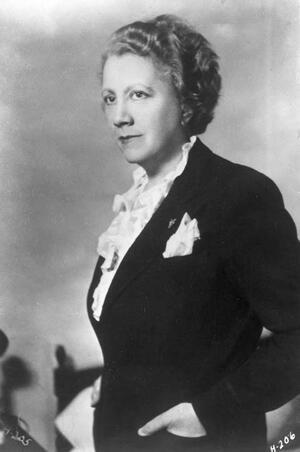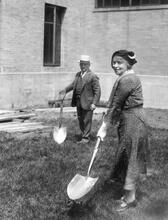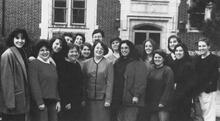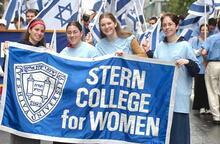Irma Levy Lindheim
Called “the grandmother” of the kibbutz for helping found and sustain multiple kibbutzim, Irma Levy Lindheim also made extensive contributions to fundraising and organizational efforts to create and maintain the State of Israel. In 1926 Lindheim briefly succeeded Henrietta Szold as president of Hadassah and kept the organization from being absorbed by the Zionist Organization of America. She moved to Palestine in 1933 and joined Kibbutz Mishmar ha-Emek. In the mid-1960s, she returned to the United States to develop programs to counteract assimilation, working with Hadassah on “Operation Jewish Survival,” a program to help Jewish mothers and grandmothers pass on a sense of Jewish identity to their children.
Irma Levy Lindheim was a colorful American Zionist millionaire, fund-raiser, and educator. Born in New York City on December 9, 1886, into a German Jewish assimilated family with roots dating back several generations in the American South, Lindheim discovered Zionism at age twenty-one. In 1926, she succeeded Henrietta Szold as president of Hadassah, the Women’s Zionist Organization of America. Then, in 1933, as a forty-seven-year-old widow and mother of five, Lindheim joined A voluntary collective community, mainly agricultural, in which there is no private wealth and which is responsible for all the needs of its members and their families.kibbutz Mishmar ha-Emek in Israel, where she remained, aside from frequent stays in the United States and elsewhere for Zionist and political activity. To create greater interest in Judaism and Zionism, she designed family-based educational programs, a project on which she worked until her death.
Family and Education
Irma’s father, Robert Levy, was a successful importer and avid businessman. Her mother, Mathilda (Morgenstern), dedicated herself to her husband and to her daughters, Amy, Edna, and Irma. Her mother and grandmother felt spiritually attached to Judaism, but lacked any form of Jewish education. Thus the family celebrated no Jewish holidays and had Christmas trees in their home.
As a child, Irma stuttered badly and compensated by voracious reading and mastery of riding, tennis, golf, and swimming. She was educated at Dr. Sachs’s Collegiate Institute for Girls, which she appreciated for its scholastic excellence and abhorred for its exclusiveness. The family’s few friends were her father’s business associates. Eastern European Jews were never welcome at home. According to her autobiography, Parallel Quest (1962), written at age seventy-six, she felt rootless and lonesome as a child.
Irma defied her father’s insistence that he select her husband, and in 1907 she married fledgling attorney Norvin R. Lindheim, a graduate of Johns Hopkins and Columbia University Law School. The couple’s five children were Norvin Jr., Donald, Richard, Hortense (Babs), and Stephen (named for Rabbi Stephen S. Wise). Upon her father’s death in 1914, Lindheim became independently wealthy.
Because Norvin Lindheim’s firm dealt with German companies and he did not serve in World War I, the U.S. Government questioned his loyalty. In 1920, he was charged with conspiring to defraud the United States and, after a very lengthy trial, found guilty. After serving a prison sentence in 1924, he appealed the verdict and was finally declared innocent in 1928, shortly after his death at age forty-seven.
In spring 1917, after the birth of her fourth child, Lindheim enlisted and became one of the few Jewish women officers in the Motor Corps. Later, challenged by an Ethical Culture teacher to learn something about her Jewishness, she visited her husband’s cousin, Hortense Guggenheimer Moses, in Baltimore, where she met American Zionists and Palestinian Jews. She was a Zionist from then on.
Political Life and Zionism
After six months, Lindheim began lecturing about Zionism. Inspired by the Balfour Declaration of 1917, she also brought Judaism home by celebrating Lit. "dedication." The 8-day "Festival of Lights" celebrated beginning on the 25th day of the Hebrew month of Kislev to commemorate the victory of the Jews over the Seleucid army in 164 B.C.E., the re-purification of the Temple and the miraculous eight days the Temple candelabrum remained lit from one cruse of undefiled oil which would have been enough to keep it burning for only one day.Hanukkah. Henrietta Szold, head of the cultural division of the American Zionist Organization, recognized Lindheim’s leadership potential, as did Judge Julian Mack, Sam Rosensohn, Abraham Tulin, and Menahem Ussishkin. Lindheim took up the challenge of chairing New York’s nonphilanthropic Seventh Zionist District by creating a cultural center whose opening was attended by Justice Louis Brandeis. The center initiated an intercollegiate Zionist organization, offered lessons to children, and provided speakers for adults. Although membership and donations soared, the Brandeis/Weizmann dispute at the 1921 Zionist Convention in Cleveland led to the center’s closing.
Dismayed by petty politics, Lindheim redirected her energies in 1922 and began studying at Rabbi Stephen S. Wise’s new Jewish Institute of Religion. Because women had never been rabbinical candidates, Lindheim wanted to pave the way. For three and a half years, she engaged in religious study at the institute while also exploring child development with Professor John Dewey at Columbia University’s Teachers College.
In 1925, Lindheim traveled to Palestine with Bertha Guggenheimer, where, as she described in The Immortal Adventure (1928), she attended the opening of Hebrew University and toured the country by horseback on a trip organized by Zionist pioneer Mania Shochat, Lindheim’s future lifelong friend. Shochat introduced Lindheim to kibbutz life and to the possibility of Arab-Jewish friendship. In Kibbutz Kefar Giladi, Shochat’s daughter Anna dubbed Lindheim “Rama,” her name thereafter in Palestine. Lindheim befriended Jewish community in Palestine prior to the establishment of the State of Israel. "Old Yishuv" refers to the Jewish community prior to 1882; "New Yishuv" to that following 1882.Yishuv (settlement) leaders, was treated for malaria in the Safed Hadassah Hospital, and toured the Negev with Rahel Yanait Ben Zvi and her husband Yizhak , who urged her to raise money for the Jewish National Fund’s project of purchasing the Negev. Lindheim took pride in Hadassah’s health services for Arabs and in Judah Magnes’s opening Hebrew University to Arab students.
Hadassah
Upon her return to the United States, Lindheim raised funds for Zionist causes and abandoned her studies. Sari Berger and Nadia Stein, emissaries from Palestine, helped her train women volunteers for the Women’s Jewish National Fund Council, later integrated into Hadassah. Lindheim then launched an extensive speaking tour and soon became the third national president of the thirty-thousand-member Hadassah in 1926. Concerned that her children did not know their heritage, Lindheim also held her first Lit. "order." The regimen of rituals, songs and textual readings performed in a specific order on the first two nights (in Israel, on the first night) of Passover.seder that year.
At that time, Hadassah faced possible absorption into the Zionist Organization of America by detractors such as Louis Lipsky. A well-run group that abided by the “100 percent clause” (that is, sending all money except dues to Palestine), Hadassah fought to preserve its autonomy. In her role as Hadassah president, Lindheim presented the case for Palestine in speeches throughout the country. In addition to health, her concerns were education, land purchase, pioneering work, and Arab-Jewish friendship. Having been director of the Child Study Association, she also tried to create programs for American parents to raise their children in the Jewish tradition. Lindheim was reelected president of Hadassah in 1927 and served as its delegate to the World Zionist Congress in Basel. At the congress’s conclusion, she flew to Palestine.
After spending time in Palestine, she planned a short return to the United States, which resulted in a more lengthy stay after the stock market crash. Ironically, the only part of her fortune saved was the money she had invested in Palestine. When Lindheim next joined Labor Zionist Po’ale Zion, Hadassah’s national board demanded her resignation on the grounds of political conflict. From then on, Lindheim was critical of Hadassah, defining herself as further to the left and entitled to political autonomy.
Lindheim next raised funds for Histadrut and Ha-Shomer ha-Za’ir, with friends Mordechai and Zipporah Bentov, members of Kibbutz Mishmar ha-Emek. Some Zionists vilified Ha-Shomer ha-Za’ir as a communist group that abetted Arab against Jew. Shocked by such charges, Lindheim returned to Palestine to investigate the accusations. Back in the United States, satisfied with her findings, she resumed her speaking tour, believing that the spirit of Palestine could help Americans during the Depression.
At the Kibbutz and in Palestine
In March 1933, Lindheim moved to Palestine with her children and tried to create a Histradrut-funded clearing house for newcomers. After attending a disillusioning Zionist Congress in Prague, she decided to abandon organizational work and join Kibbutz Mishmar ha-Emek, choosing it for its beauty and respect for individuality and privacy. Despite limited water and food on the kibbutz, Lindheim admired its system of total democracy. She worked half days in the kitchen (which she defined as productive labor) and half days on her writing, Hebrew (which she never mastered), and knitting. At forty-seven, she was an average twenty-five years older than the other kibbutz members.
During World War II, the Keren Kayemet drafted Lindheim to raise funds in England during the blitz. She also petitioned the Lord Chancellor of England to cease home-destroying searches in Palestine, for which she earned Chaim Weizmann’s praise. In 1939, her son Norvin died of illness at age thirty-one, in the United States.
In 1943, Lindheim beseeched Hadassah’s national board to work with young people to confront antisemitism and build a Zionist youth movement. In 1945, she traveled to the United States, after her son Donald died at age thirty-one in combat when Allied troops invaded Europe. She then sailed to Australia and New Zealand to raise funds for Palestine. After visiting Palestine to witness the end of British rule, she returned to the United States to help Hadassah raise money for Youth Lit. "ascent." A "calling up" to the Torah during its reading in the synagogue.aliyah. In 1948, she ran an unsuccessful campaign for the Queens congressional seat on Henry Wallace’s Progressive Party ticket, which advocated civil rights and world government.
Back in Israel, Lindheim helped create Kibbutz Adamit and Kibbutz Ein Ha-Shofet (named for shofet [judge] Louis Brandeis). In the mid-1960s, she stayed in the United States, developing educational programs to counteract assimilation among Jewish children. Returning to Israel, she was, at age seventy, lauded in the Israeli press as “the grandmother of the kibbutz” and wrote diverse articles for Zionist publications, including a lengthy appreciation of Mania Shochat, who had died in 1961.
Returning to the United States again, Lindheim tried to establish, through Hadassah, “Operation Jewish Survival,” a program to help Jewish mothers and grandmothers instill a Jewish identity in their children. In a Haaretz interview at age eighty-six, she expressed enthusiasm for the kibbutz and criticism for Israeli decadence. Lindheim spent her last years near relatives in California. She died in Berkeley on April 10, 1978, at age ninety-two.
Selected Works
The Immortal Adventure (1928)
“The Making of Young Pioneers.” Israel Horizons 10, no. 6 (June-July 1962)
Parallel Quest: A Search of a Person and People (1962).
AJYB 80:369.
BEOAJ.
EJ; Lindheim, Irma. Correspondence, July 26, 1943–August 1, 1963. Record group 7, Special Collections, Hadassah Presidents Correspondence Series, Hadassah Archives, NYC, and Papers. Bet ha-Shomer Archives, Kibbutz Kefar Giladi, Israel, and Collection A274. Central Zionist Archives, Jerusalem.
Obituary. NYTimes, April 11, 1978, 40:1.
Szold, Henrietta. Collection. Central Zionist Archives, Jerusalem.
UJE.
WWIAJ (1926, 1928, 1938).







